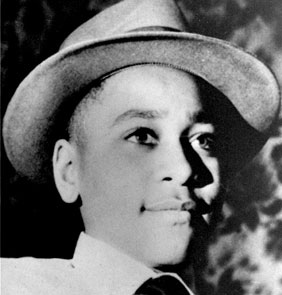Imagine sending your son to visit relatives, thinking you would see him again in a few weeks, only to learn two weeks later that he was murdered. Emmett Louis Till was born in Chicago, Illinois on July 25, 1941 to working class parents.1 His parents, both from the south, met in Argo, Illinois.2 Emmett sadly grew up without his father, after the Army executed him for raping two women and murdering a third in Italy. To add to this already hard life, Emmett got polio at a young age. Although he survived, he was left with a stutter. At school he was known as risk-taker, and he was also described as very outgoing. During the summer of 1955, Emmett’s mother sent him when he was only fourteen years old to Mississippi to visit some relatives, not knowing that she would never see her son alive again.3
Life in the south was much different than life was like where Emmett was from. He did not act the same way his cousins did around white storeowners. He talked freely about his girlfriend back home who was a white woman. One night, after a week in Mississippi, Emmett and seven other teenagers drove to a nearby town to hang out. While they were there, they went to the local grocery store owned by a white couple, Roy and Carolyn Bryant. Roy Bryant was away on a trip, and Carolyn was left in charge of the store. Several accounts exist of the events that happened next, but what is thought to have happened is the boys dared Emmett to go inside the store and ask Carolyn Bryant on a date. It is said that he went inside, bought a pack of gum, then grabbed her hand and asked her on a date. Immediately after this, she pulled away and ran into the back of the store to get a gun. During the time where she went into the back, Emmett’s cousins, realizing what had just happened, ran into the store and pulled Emmett out. As the teenagers were leaving, Emmett allegedly whistled at her and possibly even said, “bye baby!”4

After returning from his trip and finding out what had happened, Roy Bryant and his half-brother J.W. Milam went out to seek revenge. They arrived at the house of Moses Wright, Emmett’s uncle, late Saturday night, both armed with pistols. They stormed the house, ripped Emmett out from his bed, and drove off with him. His uncle pled with them, explaining Emmett was from the north and didn’t know any better, but the men refused to listen. They drove to Milam’s home where they tortured Emmett and mutilated his body. Then they took him to the Tallahatchie River where they forced him to take off all his clothes, shot him, then tied a metal fan to his body and rolled it into the river. Wright reported the kidnapping to the local sheriff the next morning, and by noon, police arrested the two men. They confessed to kidnapping him but claimed that they had let him go. Three days later, fishermen found Emmett’s body floating in the river.5
Mamie Till insisted on having Emmett’s body returned to Chicago so that she could have a funeral for him. She had an open-casket funeral so that everyone would see what had been done to her son. News of this spread immediately and caused an outbreak of protests. In Harlem, an estimated 20,000 people rallied to demand that Congress pass an anti-lynching bill.6
The trial of Roy Bryant and J.W. Milam began on September 19, 1955. Because African-Americans, and women were not allowed to serve as jurors in Mississippi, the jury was all white and all male. After four days of testimony, the jury acquitted Bryant and Milam of all charges. The two later confessed to the murder in an interview, but because of double jeopardy they were not able to be prosecuted.7
Following the news of the trial, thousands of outraged people spoke out. People began to realize that even after Brown v. Board of Education, there was still so much more that needed to be done. Citizens sent letters to their congressmen and the White House, newspapers editorials bashed the jury’s decision, and the number of people in the NAACP expanded greatly. Mamie Till spoke out on multiple occasions about the injustice that her son received. She told people to remember what happened to him and to continue fighting for justice. In addition, popular artists at the time including Gwendolyn Brooks, Toni Morrison, James Baldwin, and Bob Dylan used their own talents to create works dedicated to the Emmett and his case.8
In 2004, the FBI reopened the case. This investigation lasted three years, and during it they exhumed Till’s body to do a complete autopsy. The autopsy did not lead to any criminal charges, but it did lead to Milam’s brother confessing on his deathbed about his own involvement in the kidnapping. Till’s body was put in a new casket and his old casket was later donated to the Smithsonian’s National Museum of African American History and Culture.9
In 2008, a bill was signed into law called the Emmett Till Unsolved Civil Rights Crime Act, which provided funding to “reinvestigate crimes against civil rights workers and their allies.”10 Till’s name continues to remain in our nation’s memory, specifically through the statue of him and Dr. Martin Luther King, Jr. in Denver’s City Park, and in the Emmett Till Players that his mother formed in Chicago. Even today, his case is still being looked at. It was reopened in 2018 due to the publication of a book containing a confession from Carolyn Bryant that states she lied in her testimony during the trial.11 Even though the men who did this to Emmett Till got away with it, the nation is still fighting to get him the justice he deserves. No matter how long ago something occurred, it is never too late to seek justice.
- Encyclopedia Britannica, 2018, s.v. “Emmett Till,” by Michael Ray. ↵
- Simeon Wright and Herb Boyd, Simeon’s Story: An Eyewitness Account of the Kidnapping of Emmett Till (Chicago: Chicago Review Press, 2010), 14. ↵
- James J. Podesta, “Till, Emmett 1941-1955,” Contemporary Black Biography 7 (1994): 262-266. ↵
- James J. Podesta, “Till, Emmett 1941-1955,” Contemporary Black Biography 7 (1994): 262-266. ↵
- James J. Podesta, “Till, Emmett 1941-1955,” Contemporary Black Biography 7 (1994): 262-266. ↵
- James J. Podesta, “Till, Emmett 1941-1955,” Contemporary Black Biography 7 (1994): 262-266. ↵
- Encyclopedia Britannica, 2018, s.v. “Emmett Till,” by Michael Ray. ↵
- Salem Press Biological Encyclopedia, 2014, s.v. “Emmett Till,” by Catherine R Squires. ↵
- Encyclopedia Britannica, 2018, s.v. “Emmett Till,” by Michael Ray. ↵
- Salem Press Biological Encyclopedia, 2014, s.v. “Emmett Till,” by Catherine R Squires. ↵
- Salem Press Biological Encyclopedia, 2014, s.v. “Emmett Till,” by Catherine R Squires. ↵



49 comments
Faten Al Shaibi
The article was written well, the beginning was interesting to find out what has happened to Emmett Till,the events were sad, and more sad is the mother’s situation when seeing her child has been subjected to all this torture, I wished if each of the criminals received punishment for this heinous act. The story of Emmett one of the thousands of racist stories that tell the suffering of African Americans in that unjust time.
Damian Jennings
Emmett Louis Till grew up unfortunate, he lived without a father because his father was executed due to allegations of raping and murdering women and was convicted guilty, the penalty was death. Then years would pass and Louis Till’s , mother would live without her husband and her young boy. What a cruel world it is to be in. Murdered at such a young age and having so much potential stripped from him by a murderer.
Daniel Linstead
I have never heard of the story of Emmett Till now. It is a very sad story to read, he was just unfortunately in the wrong place at the wrong time and was unfortunately killed. I find that this happens to many young people that have grown up in the gang areas that they get caught up in the gang violence that they get caught by the cross fire etc. It is just sad.
Richard Morales
The story of Emmett Till is very disgusting and highlights the negative impact of ignorance and racism. It is sickening to hear of the evil deeds the men committed on the poor, innocent young boy. Although the all white jury did no justice for Till his death was not entirely in vain. He served as an example of the injustices of African Americans living in the United States. I am inspired by his mother’s efforts to continue to advocate for civil rights after all the pain she endured.
Aneesa Zubair
Emmett Till’s tragic murder was one of many suffered by Black people, including children like him, in the 20th century. It’s horrifying to think that people would torture and kill a young boy for something like that. I have seen pictures of Emmett Till’s open-casket funeral, and I think this was a powerful decision by Emmett’s parents to let the world see what their son had suffered. I didn’t know that the case is still being investigated today.
Madison Guerra
This article was very interesting and well written. It is horrible to read about the thing they did to Emmett and the fact that they got away with their crimes. It is sad to see what white privileged people could get away with back then, and even now. This society is still fighting for equality and there is still a lot of white privilege despite many denying it.
Karina Cardona Ruiz
I enjoyed reading your article and felt it had a strong introduction. I think you did a good job at telling Emmett Till’s story. It’s sad to think that what started off as a silly dare led to Till’s gruesome death. The fact that the jury was filled with all white men did Till’s case no favors. I can’t imagine how Till’s mother and family must have felt not only finding out he had been killed but also not getting justice for his murder.
Micaela Cruz
I once did a report on Emmett Till and reading about the horrendous things that were done to him are unthinkable and inhumane. We may not ever know what really happened that night but Till did not deserve to be mutilated in the way he was. I always thought that his mother’s decision to have an open-casket at his funeral was a bold move but a good one as well. It provided proof of what was being done to the African Americans and it’s truly uncalled for. What I didn’t know was how his mother created the Emmett Till Players in honor of him, and I admire that. It’s a shame that justice wasn’t rightfully served back then but I am glad it is being served now.
Hailey Rodriguez
I had heard of the story of Emmett Till before. It is heartbreaking to read how because he was in the wrong place at the wrong time he had to be killed. I can’t imagine how hard this was for Till’s mother. It is crazy that a man would accuse and do such a thing to a young boy who had no bad intentions whatsoever.
Katherine Watson
In one of my core classes, we discussed everything that happened leading up to Emmitt Till’s death. This poor man was accused of something that new happened and had to have his life cut short because we let race play a role in our hiacrchy. It is such a shame that Carolyn kept her secret with her up until death, but I can only hope that we can forgive her for what she has done to an innocent man.